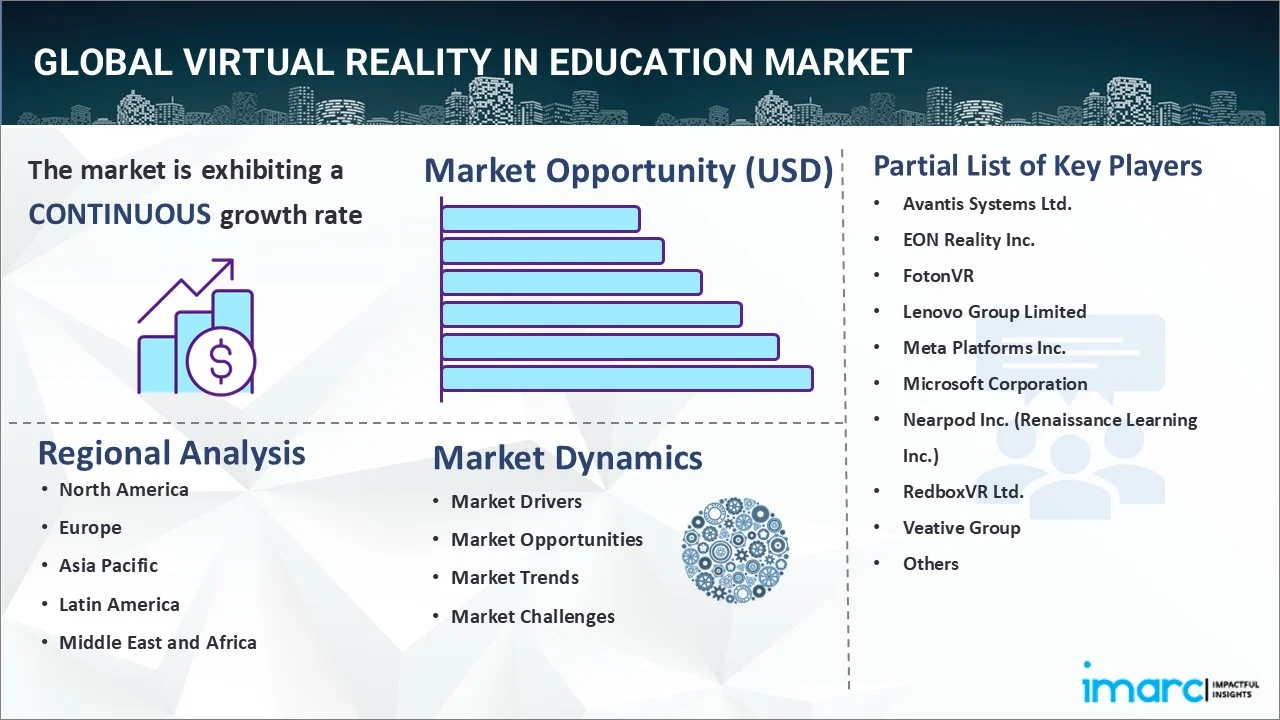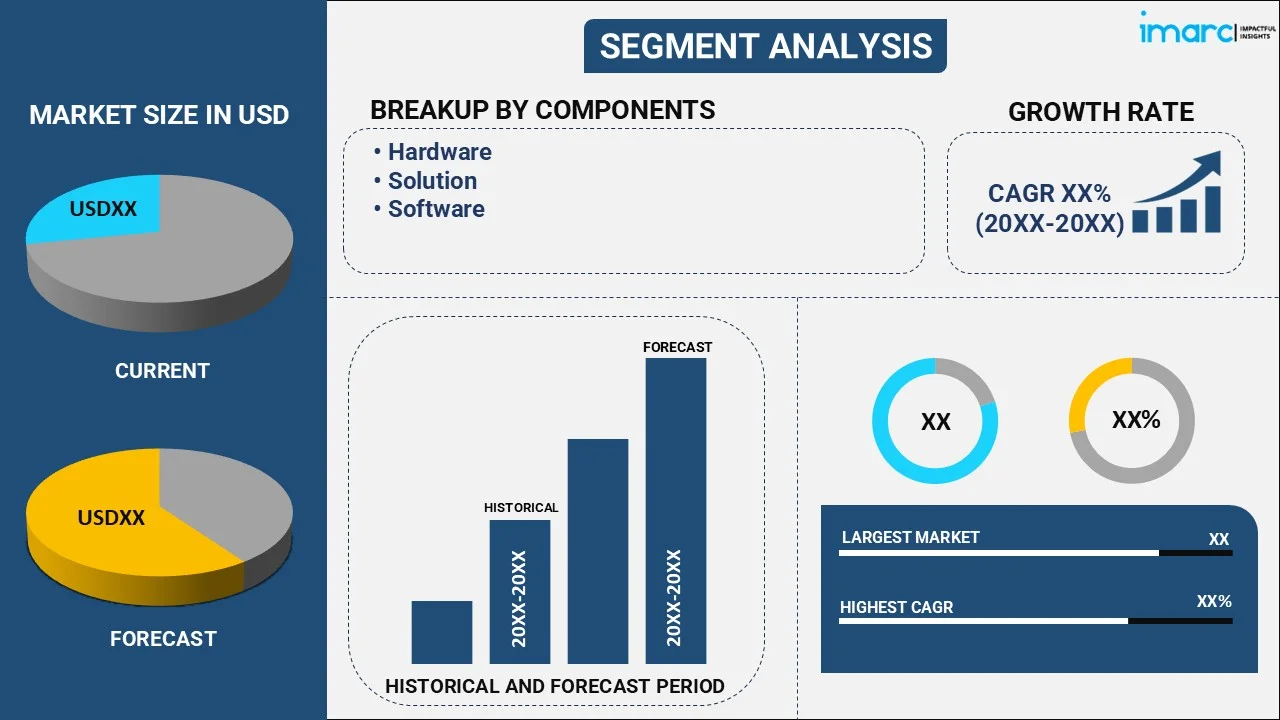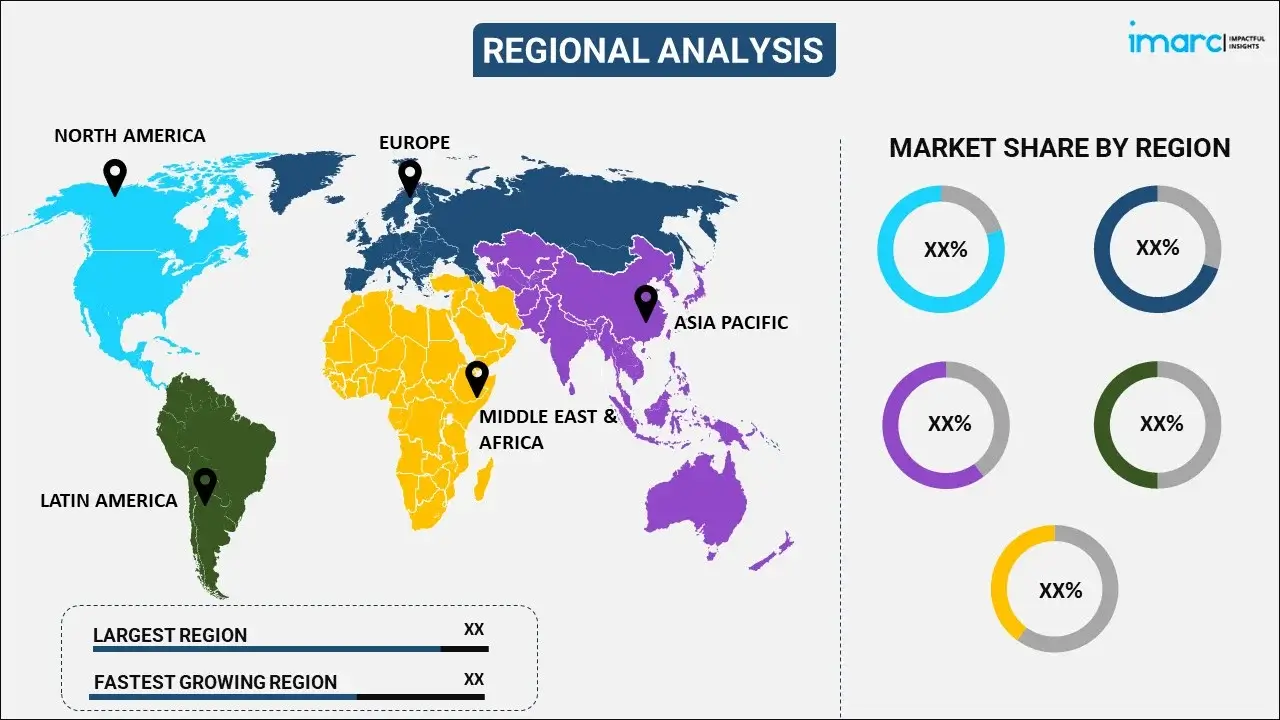
Virtual Reality in Education Market Report by Component (Hardware, Solution, Software), Deployment Mode (Cloud-based, On-premises), Application (Academic Institutions, Corporates), and Region 2025-2033
Market Overview:
The global virtual reality in education market size reached USD 5.0 Billion in 2024. Looking forward, IMARC Group expects the market to reach USD 41.3 Billion by 2033, exhibiting a growth rate (CAGR) of 25.14% during 2025-2033. Rapid technological advancements that enhance immersive learning, increased student engagement through interactive experiences, and a global shift toward personalized and customized education are some of the major factors propelling the market.
|
Report Attribute
|
Key Statistics
|
|---|---|
|
Base Year
|
2024 |
|
Forecast Years
|
2025-2033
|
|
Historical Years
|
2019-2024
|
| Market Size in 2024 | USD 5.0 Billion |
| Market Forecast in 2033 | USD 41.3 Billion |
| Market Growth Rate (2025-2033) | 25.14% |
Virtual reality (VR) in education refers to the integration of immersive technology to create a simulated environment for learning. Through the use of headsets and specialized software, students are transported into three-dimensional spaces where they can interact with objects and scenarios. At present, educators are embracing this technology to enhance comprehension and engagement, offering experiences that traditional classroom settings cannot provide. Virtual reality allows students to explore historical sites, conduct scientific experiments, and engage in various simulations, fostering a deeper understanding of subjects. It is proving especially valuable in medical, architectural, and engineering education, where hands-on experience is vital. With continued advancements, virtual reality is becoming an essential tool in modern educational practices, transforming the way learning is approached and enriching the educational journey of students around the world.

The rising consumer preference for personalized learning experiences, coupled with the increasing penetration of smart devices owing to rapid digitization, will stimulate the growth of the virtual reality in education market during the forecast period. In addition, government and institutional support play a vital role, as authorities worldwide recognize the potential of VR to innovate educational practices and are providing funding, policy support, and encouragement. Along with this, the recent coronavirus (COVID-19) pandemic has spurred the need for remote learning solutions, leading to the accelerated adoption of VR, offering students tangible and interactive learning environments at home. Furthermore, the reduction in VR equipment and software costs, driven by maturation and mass production, is making VR a more attainable option for schools and educational centers. Besides this, ongoing collaborations between academic institutions and content providers are paving the way for the creation of specialized educational materials. Such partnerships are fostering more relevant and effective learning tools designed for various educational levels and subjects. These aforementioned factors are contributing to the rapid proliferation of VR in education, cementing its position as an essential tool in modern learning landscapes, thus augmenting market growth.
Virtual Reality in Education Market Trends/Drivers:
Increased Engagement Among Students
The ability of virtual reality (VR) to provide immersive learning experiences is significantly improving engagement among students. Traditional methods may not always capture the attention and curiosity of learners, whereas VR offers a hands-on approach, allowing students to actively participate in the learning process. The interactive nature of VR stimulates interest and promotes the retention of information by appealing to various learning styles. Students can explore, manipulate, and interact with virtual objects and environments, resulting in a more profound and meaningful understanding of the subject matter. Thus, increased engagement through VR is revolutionizing the educational landscape, bridging the gap between theoretical knowledge and practical application.
Rise in Demand for Customized Learning Experiences
The global shift toward personalized education is another significant factor fueling the growth of the VR in education market. Virtual reality enables the creation of tailored learning paths, adapting to individual preferences, abilities, and learning speeds. In a VR environment, educators can design specific experiences that cater to a student's unique needs, ensuring a more efficient and targeted learning process. This customization ability facilitates a more inclusive educational approach, accommodating diverse learning requirements. As a result, the demand for such customized learning experiences is accelerating the adoption of VR in academic settings, offering a flexible and responsive approach that aligns with the evolving educational paradigms.
Ongoing Technological Advancements
The continuous technological advancements in virtual reality (VR) represent a major factor supporting market growth. Improved graphics, higher realism, and more intuitive user interfaces are making VR experiences more immersive and engaging. Enhanced hardware and more refined software solutions allow educators to simulate complex scenarios and concepts, fostering a deeper understanding. These innovations are improving the quality of VR while making it more adaptable and applicable across various educational domains. The technological progressions in VR are thus paving the way for a new era in educational methodologies, aligning with modern pedagogical needs and providing the tools for more interactive, experiential learning.
Virtual Reality in Education Industry Segmentation:
IMARC Group provides an analysis of the key trends in each segment of the global virtual reality in education market report, along with forecasts at the global, regional, and country levels for 2025-2033. Our report has categorized the market based on component, deployment mode, and application.
Breakup by Component:

- Hardware
- Solution
- Software
Hardware dominates the market
The report has provided a detailed breakup and analysis of the market based on the component. This includes hardware, solution, and software. According to the report, hardware represented the largest segment.
Hardware includes the physical devices required to enable VR experiences, such as headsets, controllers, sensors, and other input devices. The hardware allows users to interact with the virtual environment, providing immersive experiences. It represents a significant portion of the market, driven by continuous technological advancements and increased adoption across educational institutions.
Solution encompasses the integration of both hardware and software to provide a complete VR system tailored to educational needs. It includes the design and implementation of specific VR programs, curricula, or courses, aligning technology with pedagogical goals. The growth in this segment reflects the increasing demand for cohesive, ready-to-use VR solutions that can be seamlessly incorporated into existing educational frameworks.
Software consists of applications and platforms that create virtual environments and experiences within the VR system. This includes content creation tools, management systems, and specialized educational programs designed to facilitate learning in various subjects. Software development is crucial for the customization and effectiveness of VR in education, enabling the creation of content that aligns with specific educational objectives and standards.
Breakup by Deployment Mode:
- Cloud-based
- On-premises
Cloud-based represents the most popular deployment mode
A detailed breakup and analysis of the market based on the deployment mode has also been provided in the report. This includes cloud-based and on-premises. According to the report, cloud-based accounted for the largest market share.
The cloud-based deployment mode involves hosting the VR software and content on remote servers, allowing access through the internet. This model offers scalability, flexibility, and ease of access from various locations, making it appealing for educational institutions that require broad accessibility. Cloud-based VR solutions often entail lower upfront costs and provide automatic updates and maintenance, ensuring that the latest features and enhancements are readily available. The growing adoption of cloud technologies and an increased focus on collaborative and remote learning are key factors driving the expansion of this segment.
The on-premises deployment mode includes installing and maintaining the VR software and hardware within the physical location of the educational institution. This approach often provides higher levels of control, customization, and security, as the institution itself manages all aspects of the system. It may require more substantial initial investment in infrastructure and ongoing maintenance. On-premises deployment is typically chosen by organizations with specific security, compliance, or customization requirements.
Breakup by Application:
- Academic Institutions
- Corporates
Academic institutions hold the majority of the market share
The report has provided a detailed breakup and analysis of the market based on the application. This includes academic institutions and corporates. According to the report, academic institutions represented the largest segment.
Academic institutions, such as schools, colleges, universities, and other educational establishments, are increasingly adopting VR. Within academic institutions, VR is applied to enhance teaching and learning processes, providing immersive experiences that support various subjects, from history and science to arts and engineering. It offers students hands-on practice and interactive learning, improving engagement and comprehension. The inclusion of VR in academic settings is being fueled by the demand for innovative teaching methodologies and the recognition of VR's ability to provide unique learning opportunities.
In the corporate sector, VR is used primarily for training and development. It enables companies to create realistic simulations for employee training, covering areas such as safety protocols, technical skills, customer service, and leadership development. VR in corporate sector facilitates continuous learning and professional growth, aligning training with real-world scenarios and business objectives. It allows for scalable and customizable solutions that can adapt to the specific needs and goals of an organization.
Breakup by Region:

- North America
- United States
- Canada
- Europe
- Germany
- France
- United Kingdom
- Italy
- Spain
- Others
- Asia Pacific
- China
- Japan
- India
- South Korea
- Australia
- Indonesia
- Others
- Latin America
- Brazil
- Mexico
- Others
- Middle East and Africa
North America exhibits a clear dominance in the market
The report has also provided a comprehensive analysis of all the major regional markets, which include North America (the United States and Canada); Europe (Germany, France, the United Kingdom, Italy, Spain, and others); Asia Pacific (China, Japan, India, South Korea, Australia, Indonesia, and others); Latin America (Brazil, Mexico, and others); and the Middle East and Africa. According to the report, North America was the largest market for virtual reality in education.
North America, with its technological advancements and substantial investments in education and innovation, stands as a leading region in the virtual reality in education market. The presence of major VR companies and a strong focus on integrating modern technology into education contributes to the market growth in this region. Similarly, Europe's commitment to education and technological development, combined with supportive governmental policies, fuels the integration of VR in both academic and corporate education. Collaborations between educational institutions, tech companies, and governments are driving the expansion of the market in Europe.
The Asia Pacific region is also experiencing rapid growth in the VR in education market, spurred by increasing technological adoption and focus on innovative educational practices. Countries like China, Japan, and India are leading the way in implementing VR into various educational sectors. On the other hand, although still in the early stages of adopting VR in education, Latin America shows promising growth potential. Investments in education technology and collaboration with global tech companies are paving the way for the gradual integration of VR into educational systems in this region. In the Middle East and Africa, the adoption of VR in education is gaining momentum, particularly in the affluent Gulf countries. Investments in educational infrastructure and a growing interest in innovative learning methodologies are favoring the market growth in this region.
Competitive Landscape:
The market is experiencing steady growth as key players in the industry are actively engaging in research, development, and innovation to enhance their offerings. They are forging partnerships with educational institutions and content providers to create tailored solutions that align with specific learning goals. Investment in creating user-friendly interfaces, realistic simulations, and customizable content is prevalent. These industry leaders are also focused on expanding their global reach, entering emerging markets, and collaborating with governments to promote the integration of VR into various educational systems. Their concerted efforts are driving the adoption of VR across both academic and corporate sectors, contributing to the overall growth and evolution of the market.
The market research report has provided a comprehensive analysis of the competitive landscape in the global virtual reality in education market. Detailed profiles of all major companies have also been provided. Some of the key players in the market include:
- Avantis Systems Ltd.
- EON Reality Inc.
- FotonVR
- Lenovo Group Limited
- Meta Platforms Inc.
- Microsoft Corporation
- Nearpod Inc. (Renaissance Learning Inc.)
- RedboxVR Ltd.
- Veative Group
- VictoryXR Inc.
- zSpace Inc.
Virtual Reality in Education Market Report Scope:
| Report Features | Details |
|---|---|
| Base Year of the Analysis | 2024 |
| Historical Period | 2019-2024 |
| Forecast Period | 2025-2033 |
| Units | Billion USD |
| Scope of the Report | Exploration of Historical and Forecast Trends, Industry Catalysts and Challenges, Segment-Wise Historical and Predictive Market Assessment:
|
| Components Covered | Hardware, Solution, Software |
| Deployment Modes Covered | Cloud-based, On-premises |
| Applications Covered | Academic Institutions, Corporates |
| Regions Covered | Asia Pacific, Europe, North America, Latin America, Middle East and Africa |
| Countries Covered | United States, Canada, Germany, France, United Kingdom, Italy, Spain, China, Japan, India, South Korea, Australia, Indonesia, Brazil, Mexico |
| Companies Covered | Avantis Systems Ltd., EON Reality Inc., FotonVR, Lenovo Group Limited, Meta Platforms Inc., Microsoft Corporation, Nearpod Inc. (Renaissance Learning Inc.), RedboxVR Ltd., Veative Group, VictoryXR Inc., zSpace Inc., etc. |
| Customization Scope | 10% Free Customization |
| Post-Sale Analyst Support | 10-12 Weeks |
| Delivery Format | PDF and Excel through Email (We can also provide the editable version of the report in PPT/Word format on special request) |
Key Questions Answered in This Report:
- How has the global virtual reality in education market performed so far, and how will it perform in the coming years?
- What are the drivers, restraints, and opportunities in the global virtual reality in education market?
- What is the impact of each driver, restraint, and opportunity on the global virtual reality in education market?
- What are the key regional markets?
- Which countries represent the most attractive virtual reality in education market?
- What is the breakup of the market based on the component?
- Which is the most attractive component in the virtual reality in education market?
- What is the breakup of the market based on the deployment mode?
- Which is the most attractive deployment mode in the virtual reality in education market?
- What is the breakup of the market based on the application?
- Which is the most attractive application in the virtual reality in education market?
- What is the competitive structure of the global virtual reality in education market?
- Who are the key players/companies in the global virtual reality in education market?
Key Benefits for Stakeholders:
- IMARC’s industry report offers a comprehensive quantitative analysis of various market segments, historical and current market trends, market forecasts, and dynamics of the virtual reality in education market from 2019-2033.
- The research report provides the latest information on the market drivers, challenges, and opportunities in the global virtual reality in education market.
- The study maps the leading, as well as the fastest-growing, regional markets. It further enables stakeholders to identify the key country-level markets within each region.
- Porter's five forces analysis assist stakeholders in assessing the impact of new entrants, competitive rivalry, supplier power, buyer power, and the threat of substitution. It helps stakeholders to analyze the level of competition within the virtual reality in education industry and its attractiveness.
- Competitive landscape allows stakeholders to understand their competitive environment and provides an insight into the current positions of key players in the market.
Need more help?
- Speak to our experienced analysts for insights on the current market scenarios.
- Include additional segments and countries to customize the report as per your requirement.
- Gain an unparalleled competitive advantage in your domain by understanding how to utilize the report and positively impacting your operations and revenue.
- For further assistance, please connect with our analysts.
 Request Customization
Request Customization
 Speak to an Analyst
Speak to an Analyst
 Request Brochure
Request Brochure
 Inquire Before Buying
Inquire Before Buying




.webp)




.webp)












